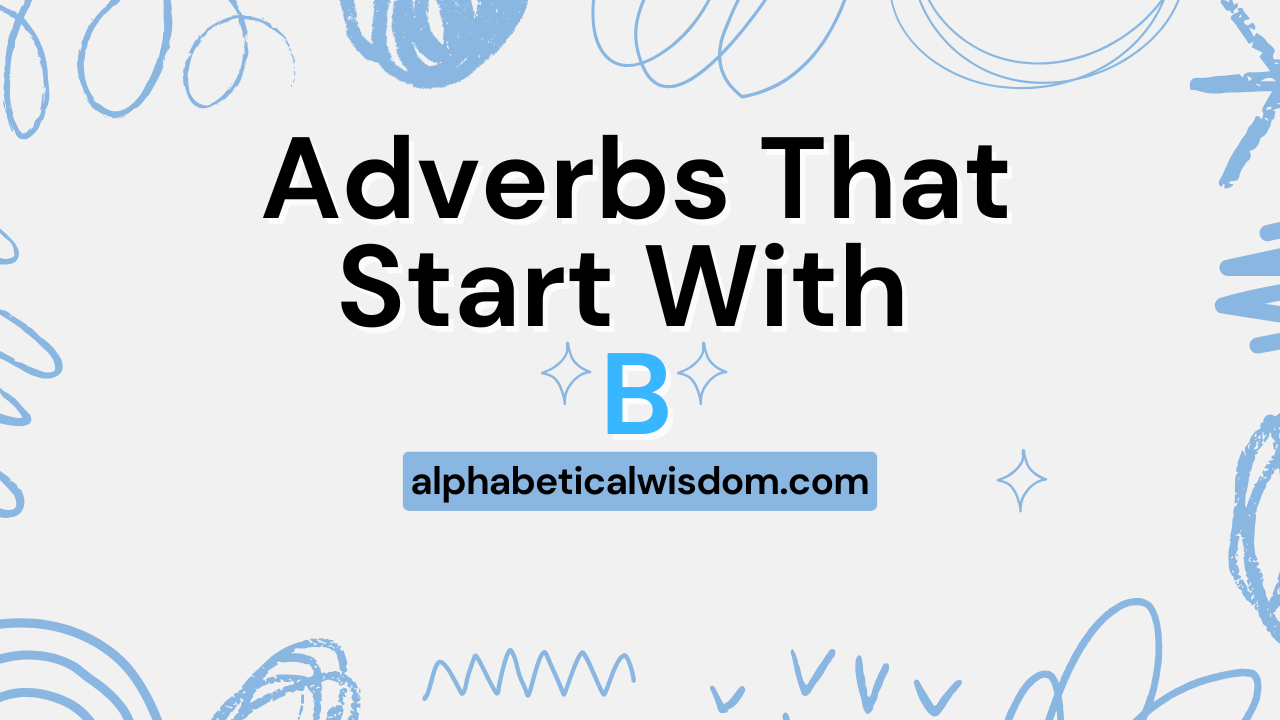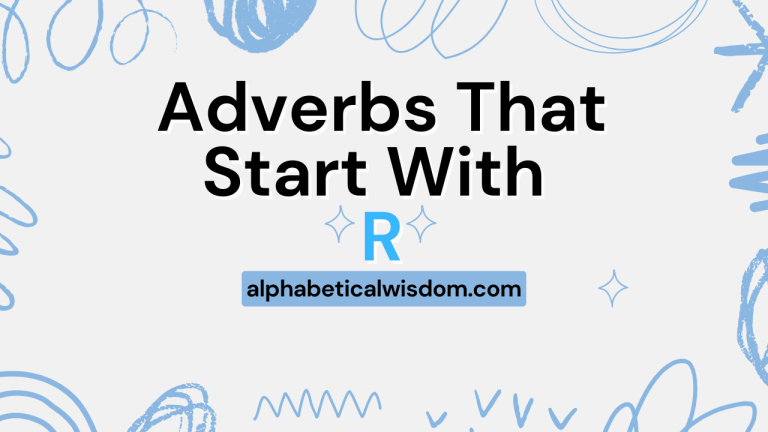Adverbs That Start With B: A Comprehensive Guide
Adverbs are essential components of the English language, enriching sentences by providing additional information about verbs, adjectives, or other adverbs. Mastering adverbs, particularly those starting with the letter “B,” can significantly enhance your ability to express nuances, describe actions more vividly, and construct more sophisticated and precise sentences.
This guide is designed for English language learners of all levels, from beginners seeking a foundational understanding to advanced speakers aiming to refine their grammatical skills. By exploring the diverse range of adverbs beginning with “B,” we will delve into their definitions, structural roles, usage rules, and common pitfalls, equipping you with the knowledge and practice needed to use them confidently and correctly.
Table of Contents
- Introduction
- Definition of Adverbs
- Structural Breakdown
- Types of Adverbs Starting With B
- Examples of Adverbs Starting With B
- Usage Rules for Adverbs Starting With B
- Common Mistakes with Adverbs Starting With B
- Practice Exercises
- Advanced Topics
- Frequently Asked Questions
- Conclusion
Definition of Adverbs
An adverb is a word that modifies a verb, an adjective, another adverb, a phrase, or a clause. Adverbs provide additional information about how, where, when, to what extent, or how frequently something is done.
They add detail and precision to sentences, making them more descriptive and informative. Understanding the function of adverbs is crucial for effective communication in English.
Adverbs can be classified based on their function. Some common categories include:
- Adverbs of Manner: Describe how an action is performed (e.g., bravely, badly, beautifully).
- Adverbs of Place: Indicate where an action takes place (e.g., below, behind, beside).
- Adverbs of Time: Specify when an action occurs (e.g., before, briefly, by then).
- Adverbs of Degree: Show to what extent something is done (e.g., barely, completely, fully).
- Adverbs of Frequency: Indicate how often an action occurs (e.g., briefly, regularly, occasionally).
Structural Breakdown
Adverbs can consist of a single word or a phrase. Single-word adverbs are often formed by adding the suffix “-ly” to an adjective (e.g., bad becomes badly). However, many adverbs do not follow this pattern and exist as independent words (e.g., before, behind). Adverbial phrases consist of two or more words that function together as an adverb (e.g., by far, in brief).
The basic structure of an adverb in a sentence involves its placement relative to the word it modifies. While adverbs can often appear in various positions, their placement can affect the emphasis and clarity of the sentence.
Understanding these structural patterns is key to using adverbs effectively.
Consider these examples:
- Before, I used to live in New York. (Adverb modifying the entire clause)
- He stood behind the tree. (Adverb modifying the verb “stood”)
- She sang beautifully. (Adverb modifying the verb “sang”)
Types of Adverbs Starting With B
Adverbs beginning with the letter “B” cover a wide range of meanings and functions. Let’s explore some of the most common types:
Adverbs of Manner
Adverbs of manner describe how an action is performed. They provide details about the way something is done. Examples include: badly, beautifully, bravely.
Adverbs of Place
Adverbs of place indicate where an action occurs. They specify the location or direction of an action. Examples include: below, behind, beside.
Adverbs of Time
Adverbs of time specify when an action takes place. They provide information about the timing or duration of an event. Examples include: before, briefly, by then.
Adverbs of Degree
Adverbs of degree indicate the intensity or extent of an action or quality. They modify adjectives, verbs, or other adverbs to show the degree to which something is true. Examples include: barely, basically, bitterly.
Adverbs of Frequency
Adverbs of frequency indicate how often an action occurs. They specify the regularity or repetition of an event. While not many adverbs of frequency start with ‘b’, ‘briefly’ can sometimes function in this way depending on context. Examples include: briefly (when referring to short, repeated instances).
Examples of Adverbs Starting With B
To illustrate the use of adverbs starting with “B,” let’s examine examples organized by category:
Adverbs of Manner Examples
Adverbs of manner describe how an action is performed. The table below demonstrates various adverbs of manner starting with ‘B’ used in sentences.
| Adverb of Manner | Example Sentence |
|---|---|
| Badly | He played the guitar badly. |
| Beautifully | She sang beautifully at the concert. |
| Bravely | The firefighter acted bravely to save the family. |
| Blindly | He followed her blindly, trusting her completely. |
| Boldly | She spoke boldly against the injustice. |
| Boisterously | The children played boisterously in the park. |
| Breathlessly | She ran breathlessly to catch the bus. |
| Brightly | The sun shone brightly in the sky. |
| Brilliantly | He solved the problem brilliantly. |
| Broadly | He smiled broadly when he saw her. |
| Brutally | The dictator treated his people brutally. |
| Balefully | The villain glared balefully at the hero. |
| Bashfully | The young boy smiled bashfully when complimented. |
| Beneficially | The new policy affected the community beneficially. |
| Benignly | The teacher smiled benignly at her students. |
| Best | He performed his best in the final competition. |
| Better | She managed the project better than expected. |
| Bitterly | She wept bitterly after the argument. |
| Bleakly | He stared bleakly at the deserted landscape. |
| Blessedly | She slept blessedly through the night. |
| Blandly | He spoke blandly, avoiding any controversial topics. |
| Blankly | She stared blankly at the empty screen. |
| Bluntly | He spoke bluntly, not caring about feelings. |
| Blurrily | He saw the world blurrily without his glasses. |
| Boyishly | He grinned boyishly, excited about the game. |
| Briskly | She walked briskly to the office. |
| Briskly | The salesperson handled the transaction briskly. |
| Brotherly | He behaved brotherly towards his friends. |
| Buffly | He talked buffly about his workout routine. |
Adverbs of Place Examples
Adverbs of place indicate where an action occurs. Consider the following examples in the table below:
| Adverb of Place | Example Sentence |
|---|---|
| Below | The temperature dropped below freezing. |
| Behind | The cat hid behind the sofa. |
| Beside | She sat beside him on the bench. |
| Back | He went back to his hometown. |
| Beyond | The mountains lie beyond the valley. |
| Board | The passengers went board the ship. |
| Bottom | The treasure was buried at the bottom of the sea. |
Adverbs of Time Examples
Adverbs of time specify when an action takes place. Here are some examples:
| Adverb of Time | Example Sentence |
|---|---|
| Before | I had seen that movie before. |
| Briefly | He spoke briefly about his plans. |
| By then | By then, the rain had stopped. |
| Back then | Back then, life was simpler. |
Adverbs of Degree Examples
Adverbs of degree indicate the intensity or extent of an action or quality. Study the table below.
| Adverb of Degree | Example Sentence |
|---|---|
| Barely | I barely had enough time to catch the train. |
| Basically | The plan is basically complete. |
| Bitterly | She was bitterly disappointed by the news. |
| Boundlessly | He believed in the project boundlessly. |
Adverbs of Frequency Examples
Adverbs of frequency indicate how often an action occurs. Note the examples in the table.
| Adverb of Frequency | Example Sentence |
|---|---|
| Briefly | He visits his parents briefly every month. |
Usage Rules for Adverbs Starting With B
Using adverbs correctly involves understanding their placement and how they interact with other parts of speech.
Placement of Adverbs
The placement of adverbs can vary depending on the type of adverb and the desired emphasis. Adverbs of manner often appear after the verb or after the object if there is one.
Adverbs of time and place can appear at the beginning, middle, or end of a sentence. Adverbs of degree usually come before the word they modify.
The placement of the adverb changes the emphasis of the sentence.
Examples:
- She sang beautifully. (Adverb of manner after the verb)
- Before, I lived in London. (Adverb of time at the beginning of the sentence)
- I barely know him. (Adverb of degree before the verb)
Comparative and Superlative Forms
Some adverbs, particularly adverbs of manner, can have comparative and superlative forms. These forms are used to compare the degree to which an action is performed.
For adverbs ending in “-ly,” use “more” and “most” to form the comparative and superlative, respectively. For some shorter adverbs, you can add “-er” and “-est,” similar to adjectives.
Examples:
- She sang more beautifully than her sister. (Comparative)
- He performed the task the most badly of all. (Superlative)
Exceptions and Special Cases
Some adverbs have irregular forms or unique usage patterns. Be aware of these exceptions to avoid errors.
For example, the adverb “well” is the adverbial form of the adjective “good.” It is irregular because it does not follow the typical “-ly” pattern. Also, some words can function as both adverbs and prepositions, such as “before” and “behind.” The context of the sentence determines their function.
Common Mistakes with Adverbs Starting With B
One common mistake is using adjectives instead of adverbs. For example, saying “He sings beautiful” instead of “He sings beautifully.” Another common error is incorrect placement of adverbs, which can change the meaning of the sentence or make it sound awkward.
Additionally, learners sometimes misuse comparative and superlative forms.
| Incorrect | Correct | Explanation |
|---|---|---|
| He sings beautiful. | He sings beautifully. | Using an adjective instead of an adverb to modify the verb “sings.” |
| Before I have seen that movie. | I have seen that movie before. | Incorrect placement of the adverb “before.” |
| She performed badder than him. | She performed worse than him. | Using the incorrect comparative form of “badly.” |
Practice Exercises
Test your understanding of adverbs starting with “B” with these exercises:
Exercise 1: Identifying Adverbs
Identify the adverbs in the following sentences:
| Question | Answer |
|---|---|
| 1. She danced beautifully. | beautifully |
| 2. He stood behind the building. | behind |
| 3. Before, I lived in Paris. | Before |
| 4. I barely finished the test. | barely |
| 5. He spoke briefly. | briefly |
| 6. The cat jumped bravely across the gap. | bravely |
| 7. The children played boisterously. | boisterously |
| 8. The sun shone brightly. | brightly |
| 9. He solved the puzzle brilliantly. | brilliantly |
| 10. She smiled broadly when she saw him. | broadly |
Exercise 2: Using Adverbs in Sentences
Fill in the blanks with an appropriate adverb starting with “B”:
| Question | Answer |
|---|---|
| 1. He sang ______ at the concert. | beautifully |
| 2. The treasure was buried ______ the ground. | below |
| 3. I had met him ______. | before |
| 4. She could ______ understand what he was saying. | barely |
| 5. He spoke ______, outlining the main points. | briefly |
| 6. The soldier fought ______. | bravely |
| 7. The fans cheered ______. | boisterously |
| 8. The stars twinkled ______. | brightly |
| 9. He planned the event ______. | brilliantly |
| 10. She smiled ______ at his joke. | broadly |
Exercise 3: Correcting Errors
Correct the errors in the following sentences:
| Question | Answer |
|---|---|
| 1. She danced good. | She danced well. |
| 2. I have seen him beforely. | I have seen him before. |
| 3. He performed bad than her. | He performed worse than her. |
| 4. The sun shines bright. | The sun shines brightly. |
| 5. He is basically finish. | He is basically finished. |
| 6. The child behaved boisterous. | The child behaved boisterously. |
| 7. She spoke blunt. | She spoke bluntly. |
| 8. He ran breathless to the station. | He ran breathlessly to the station. |
| 9. They accepted the offer blind. | They accepted the offer blindly. |
| 10. He acted brave. | He acted bravely. |
Advanced Topics
For advanced learners, let’s explore more complex aspects of adverbs starting with “B”:
Conjunctive Adverbs Starting With B
Conjunctive adverbs connect two independent clauses, showing the relationship between them. While there aren’t many common conjunctive adverbs starting with ‘B’, understanding how adverbs can connect clauses is essential. Examples of conjunctive adverbs in general include: however, therefore, moreover. These are not adverbs starting with ‘B’ but illustrate the concept.
Example (using ‘besides’ as a conjunctive adverb, though it doesn’t strictly function as one at the start of a clause as typically):
- He was tired; besides, he had other commitments.
Adverbial Phrases Starting With B
Adverbial phrases are groups of words that function as adverbs, modifying verbs, adjectives, or other adverbs. Many adverbial phrases start with prepositions, but some can incorporate adverbs starting with “B.”
Examples:
- By far, this is the best solution.
- He finished the project by then.
- Beyond any doubt, she is the best candidate.
Frequently Asked Questions
Here are some common questions about adverbs starting with “B”:
- What is the difference between an adverb and an adjective?
Adjectives modify nouns, while adverbs modify verbs, adjectives, or other adverbs. Adjectives describe the qualities of a noun, whereas adverbs describe how, when, where, or to what extent something is done. For example, “beautiful” is an adjective (a beautiful flower), and “beautifully” is an adverb (she sings beautifully).
- How do I form adverbs from adjectives?
Many adverbs are formed by adding the suffix “-ly” to an adjective. For example, “quick” becomes “quickly,” and “brave” becomes “bravely.” However, some adjectives already end in “-ly” (e.g., “friendly”), and some adverbs have irregular forms (e.g., “good” becomes “well”).
- Where should I place an adverb in a sentence?
The placement of an adverb depends on the type of adverb and the desired emphasis. Adverbs of manner often come after the verb or object. Adverbs of time and place can appear at the beginning, middle, or end of the sentence. Adverbs of degree usually precede the word they modify. Experiment with different placements to see how they affect the meaning and flow of the sentence.
- Can a word be both an adverb and a preposition?
Yes, some words can function as both adverbs and prepositions, depending on the context. For example, “before” can be an adverb (I have seen him before) or a preposition (before the meeting). As an adverb, *before* modifies the verb *have seen*. As a preposition, it introduces a prepositional phrase modifying the noun *meeting*.
- What are comparative and superlative adverbs?
Comparative adverbs compare the degree to which an action is performed (e.g., “more quickly”). Superlative adverbs indicate the highest degree to which an action is performed (e.g., “most quickly”). For adverbs ending in “-ly,” use “more” and “most” to form the comparative and superlative. Some shorter adverbs can add “-er” and “-est.”
- Why is adverb placement important?
Adverb placement is crucial because it affects the meaning and emphasis of a sentence. Placing an adverb in different positions can subtly alter the focus or clarity of the statement. For example, “Only I saw the accident” means that I was the sole witness, while “I only saw the accident” means that I merely saw it, without any further involvement.
- Are there any adverbs that don’t end in ‘-ly’?
Yes, many adverbs do not end in ‘-ly’. These include adverbs of time (e.g., now, then, today), adverbs of place (e.g., here, there, above), and some adverbs of manner and degree (e.g., well, fast, very). It’s important to recognize these as adverbs based on their function in the sentence, rather than relying solely on the ‘-ly’ suffix.
- How can I improve my use of adverbs in writing?
To improve your use of adverbs, focus on variety and precision. Avoid overusing common adverbs like “very” or “really,” and instead, seek out more descriptive and specific adverbs that add depth to your writing. Pay attention to adverb placement to ensure clarity and desired emphasis. Additionally, read widely and notice how skilled writers use adverbs effectively.
- Can adverbs modify entire sentences?
Yes, some adverbs, known as sentence adverbs or disjuncts, can modify entire sentences. These adverbs express the speaker’s attitude or opinion about the statement. Examples include: fortunately, unfortunately, honestly, and clearly. For instance, “Fortunately, the rain stopped before the picnic” expresses the speaker’s positive sentiment about the event.
- What is the function of adverbs of degree in a sentence?
Adverbs of degree indicate the intensity or extent of an action, quality, or manner. They modify verbs, adjectives, or other adverbs to show how much or to what degree something is done. Common examples include: very, extremely, quite, barely, and almost. These adverbs help to fine-tune the meaning of a sentence by specifying the level of intensity.
Conclusion
Mastering adverbs, particularly those starting with the letter “B,” is crucial for enhancing your English language skills. By understanding their definitions, structural roles, usage rules, and common pitfalls, you can use them confidently and correctly.
Remember to pay attention to adverb placement, avoid common mistakes, and practice regularly to improve your fluency and accuracy. With consistent effort, you can effectively incorporate adverbs into your speech and writing, adding depth and precision to your communication.
Keep practicing, and you’ll see significant improvements in your English proficiency.






